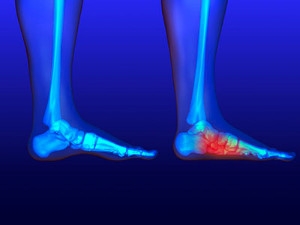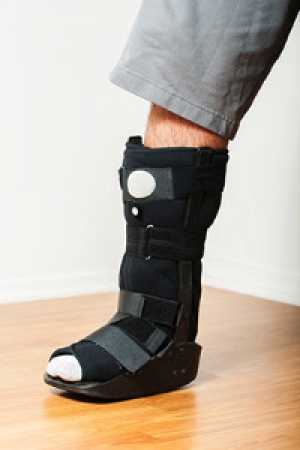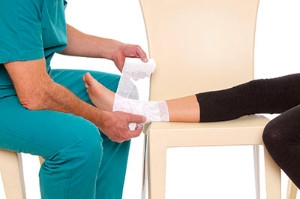Featured Articles
Super User
What Are Hammertoes?
Hammertoes are painful deformities that frequently form on the second, third, or fourth toe. The condition is often caused by an issue in foot mechanics. This can be caused by the person’s specific gait or the manner in which they walk, or by shoes that do not comfortably fit the deformity. Hammertoes can be formed after wearing shoes that are too narrow or short for the foot or have excessively high heels. Shoes that are not properly sized will force the toes into a bent position for long periods of time. This can cause the muscles to shorten and toes to bend into the deformity of a hammertoe.
Hammertoe can also be caused by complications from rheumatoid arthritis, osteoarthritis, trauma to the foot, heredity, or a cerebral vascular accident. Pain and difficult mobility of the toes, deformities, calluses, and corns are all symptoms of a hammertoe.
Someone who suspects they have the symptoms of a hammertoe should consult with a physician—particularly a podiatrist. Podiatrists diagnose and treat complications of the foot and ankle. If the podiatrist discovers that the affected toes are still flexible, treatment for the hammertoe may simply involve exercise, physical therapy, and better-fitting shoes. Treatment for hammertoes typically involves controlling foot mechanics, such as walking, through the use of customized orthotics.
For more serious cases in which the toes have become inflexible and rigid, surgery may be suggested. During the operation, the toe would receive an incision to relieve pressure on the tendons. A re-alignment of the tendons may then be performed by removing small pieces of bone to straighten the toe. In some cases, the insertion of pins is needed to keep the bones in the proper position as the toe heals. The patient is usually allowed to return home on the same day as the surgery.
If surgery is performed to repair a hammertoe, following the postoperative directions of your doctor is essential. Directions may include several stretches, picking up marbles with your toes, or attempting to crumple a towel placed flat against your feet. Wear shoes that have low heels and a wide amount of toe space to maintain comfort. Closed-toe shoes and high heels should be avoided. Shoes with laces allow the wearer to adjust how fitted he or she may want the shoes to be and also allow for greater comfort. To provide adequate space for your toes, select shoes that have a minimum of one-half inch of space between the tip of your longest toe and the inside of the shoe. This will also relieve pressure on your toes and prevent future hammertoes from forming.
Other preventative measures that can be taken include going shopping for new shoes in the middle of the day. Your feet are its smallest in the morning and swell as the day progresses. Trying on and purchasing new shoes midday will give you the most reliable size. Be sure to check that the shoes you purchase are both the same size. If possible, ask the store to stretch out the shoes at its painful points to allow for optimum comfort.
Preventing Falls in Cold Weather
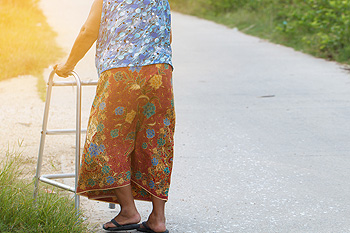 Research has shown the unnatural act of falling may be common among senior citizens. According to a portion of an AARP bulletin, deaths from falling is among the highest in the cold states of Wisconsin and Minnesota. In places where there may be an accumulation of snow, it may be beneficial to wear shoes that have traction or cleats, and this may aid in preventing any falls that may occur. If you must walk outside for extended periods of time, it may be helpful to look at your pathway a few steps in advance, and this may prevent any slipping on black ice. In addition to properly preparing your trek outside, it is important to check the condition of your home and remove items that may cause tripping. These may include repairing or replacing any loose carpeting and moving any extension cords that may be a falling hazard. If you have endured a fall and have injured your ankles or feet, it is suggested to speak with a podiatrist so proper treatment can begin.
Research has shown the unnatural act of falling may be common among senior citizens. According to a portion of an AARP bulletin, deaths from falling is among the highest in the cold states of Wisconsin and Minnesota. In places where there may be an accumulation of snow, it may be beneficial to wear shoes that have traction or cleats, and this may aid in preventing any falls that may occur. If you must walk outside for extended periods of time, it may be helpful to look at your pathway a few steps in advance, and this may prevent any slipping on black ice. In addition to properly preparing your trek outside, it is important to check the condition of your home and remove items that may cause tripping. These may include repairing or replacing any loose carpeting and moving any extension cords that may be a falling hazard. If you have endured a fall and have injured your ankles or feet, it is suggested to speak with a podiatrist so proper treatment can begin.
Preventing falls among the elderly is very important. If you are older and have fallen or fear that you are prone to falling, consult with Dr. Dean D. Hinners from Illinois. Our doctor will assess your condition and provide you with quality advice and care.
Every 11 seconds, an elderly American is being treated in an emergency room for a fall related injury. Falls are the leading cause of head and hip injuries for those 65 and older. Due to decreases in strength, balance, senses, and lack of awareness, elderly persons are very susceptible to falling. Thankfully, there are a number of things older persons can do to prevent falls.
How to Prevent Falls
Some effective methods that older persons can do to prevent falls include:
- Enrolling in strength and balance exercise program to increase balance and strength
- Periodically having your sight and hearing checked
- Discuss any medications you have with a doctor to see if it increases the risk of falling
- Clearing the house of falling hazards and installing devices like grab bars and railings
- Utilizing a walker or cane
- Wearing shoes that provide good support and cushioning
- Talking to family members about falling and increasing awareness
Falling can be a traumatic and embarrassing experience for elderly persons; this can make them less willing to leave the house, and less willing to talk to someone about their fears of falling. Doing such things, however, will increase the likelihood of tripping or losing one’s balance. Knowing the causes of falling and how to prevent them is the best way to mitigate the risk of serious injury.
If you have any questions, please feel free to contact one of our offices located in Metropolis and Eldorado, IL . We offer the newest diagnostic and treatment technologies for all your foot care needs.
Read more about Falls PreventionFalls Prevention
Elderly Americans are very susceptible to falls as they get older. Everyone experiences decreases in flexibility, balance, strength, and the senses as they age. This correlates to some eye-opening statistics. 1 in 4 Americans aged 65 and older fall each year. An elderly American is being treated for a fall in an emergency room every 11 seconds, and every 19 minutes, an older person dies from falling. In light of these striking statistics, one can see the importance of taking steps to prevent falls.
Finding an exercise program for the elderly is an excellent way to reduce the likelihood of falls. Look for an exercise program that improves strength and balance. Elderly people who live a more sedentary lifestyle, with little physical activity, are at an increased risk of falling. Wearing well-fitted footwear that provides good foot support and cushion will help prevent falls from poorly fitted shoes. Talking to a podiatrist about your susceptibility to falls and about inspecting your prescriptions will help to avoid any medication that could make falls more likely. Due to a decline in the senses among the elderly, having your eyes and hearing checked is recommended.
Around half of all falls occur in the household. Removing tripping hazards in the home and making it more accommodating to older persons can significantly reduce falls. Some notable household changes include increasing lighting around the house, installing grab bars in the shower and bathroom, and making sure the floor is clear of clutter. Other smart options include installing a shower chair, using rubber-bottomed rugs, and placing railings on both sides of stairwells.
Finally, discuss with a doctor and your family about your fear of falling. This will help to increase awareness among the population on the need for fall prevention. A lack of awareness on the matter, and a downplaying of importance are what increase the risks of falling. Following these tips can help to reduce the risk for yourself and your loved ones.
What Time of Day Should Running Shoes Be Purchased?
 Research has shown that the importance of buying the correct shoes for running may be based on the amount of mileage that is covered and the type of running that is practiced. Additionally, many runners recognize that the shape of the foot may play a significant role in the style of shoe that is chosen. When purchasing shoes, it may be beneficial to try them on later in the day when the feet are typically at their largest. The toes must have enough room to move within the shoe, and the ankle and foot can maintain stability when the heel is solid. When socks that are worn for running are dusted with baby powder, excess moisture that may come from excess sweat may be absorbed and uncomfortable blisters may be avoided. If you would like additional information on how to choose the proper running shoe, please speak with a podiatrist.
Research has shown that the importance of buying the correct shoes for running may be based on the amount of mileage that is covered and the type of running that is practiced. Additionally, many runners recognize that the shape of the foot may play a significant role in the style of shoe that is chosen. When purchasing shoes, it may be beneficial to try them on later in the day when the feet are typically at their largest. The toes must have enough room to move within the shoe, and the ankle and foot can maintain stability when the heel is solid. When socks that are worn for running are dusted with baby powder, excess moisture that may come from excess sweat may be absorbed and uncomfortable blisters may be avoided. If you would like additional information on how to choose the proper running shoe, please speak with a podiatrist.
You should always make sure your running shoes fit properly in order to avoid injury. For more information, contact Dr. Dean D. Hinners from Illinois. Our doctor can provide the care you need to keep you pain-free and on your feet.
Choosing the Right Running Shoe for Your Foot Type
Improper shoe sizing can cause a myriad of problems for your feet. Shoes that don’t fit you properly can lead to muscular imbalances in your body, which can result in foot, knee, and hip injuries.
Tips for Finding the Right Running Shoe
- Make sure you have a thumb’s width of wiggle room between the end of your longest toe and the front of the shoe.
- There should be little to no slipping at the heel
- Don’t assume your size in one shoe brand will be your size in another
- Do not lace up your shoes too tightly
- Walk around in the store with your new shoes before you buy them
If you have any questions please feel free to contact our one of our offices located in Metropolis and Eldorado, IL . We offer the newest diagnostic and treatment technologies for all your foot and ankle needs.
Read more about Choosing the Right Running ShoeChoosing the Right Running Shoe
Choosing the right running shoes for you is an important part of running. A good pair of running shoes will make the running experience more enjoyable for you and prevent potential injury.
Poorly-fitted shoes can increase the risk of injury in runners substantially. Common injuries from running with poor quality shoes include shin splints, sprained ankles, Achilles tendinitis, stress fractures, plantar fasciitis and more. This is due to the fact that bad shoes do not provide proper foot support, can increase pronation (how much the foot rolls when hitting the ground), have little to no cushioning, do not allow the feet to breath, and do not provide enough flex and rigidity in the right parts.
When looking for running shoes, first, determine where you will be running. If you are a trail runner, then pick trail shoes. If you run on concrete and asphalt, then regular running shoes are the best choice. When trying on shoes, its best to go at the end of the day as feet grow during the day and shrink after a night of sleep. Shoes should be more rigid towards the back of the foot while being more flexible up where the toes are. The toe box should provide enough room for the toes to move freely. The overall fit should be snug, not too tight but not too loose. A good pair of running shoes should also provide enough arch support for your foot type. If you experience overpronation or under-pronation while running, try to find a pair of shoes that will help correct this with different sole patterns. Finally, try to find a pair of shoes that allow the feet to breathe like nylon mesh or synthetic leather.
Don’t forget about the socks either. Socks that hold too much moisture can lead to athlete’s foot. Socks should be breathable so that your feet can air out and breathe. Synthetic socks wick away moisture like sweat. If you tend to run a lot, having a second pair of shoes that you can wear while you let the first pair air out is smart. Just don’t forget to replace your shoes after about every 300 to 500 miles.
Before you start running, it is advised to see a podiatrist to see if running is right for you. They can also offer good advice on how to run and what to look for in a pair of running shoes. If you have flat feet or poorly supported ones, they can also offer custom-made orthotics that will help give your feet the support they need.
Flat Feet May Gradually Disappear with Age
 The medical term that is referred to as flat feet is indicative of the arches in the foot appearing lower than what is classified as normal. Most babies are born with flat feet, and the arches will gradually develop as the aging process occurs. Some patients will have flat feet, or fallen arches throughout their lives, and this may be a result of improper development of the arches during childhood. Noticeable symptoms of this condition may be discomfort and pain in the area where the arch should be, in addition to possible heel pain. Patients whose arches have not properly developed may experience frequent falling or tripping or may notice considerable weakness or pain in the feet. Research has indicated that wearing shoes, which are more supportive may aid in living with flat feet, in addition to performing gentle stretches, which may improve overall flexibility of the foot. If you have this condition, it is important to consult with a podiatrist, who can properly guide you to implement correct treatment techniques.
The medical term that is referred to as flat feet is indicative of the arches in the foot appearing lower than what is classified as normal. Most babies are born with flat feet, and the arches will gradually develop as the aging process occurs. Some patients will have flat feet, or fallen arches throughout their lives, and this may be a result of improper development of the arches during childhood. Noticeable symptoms of this condition may be discomfort and pain in the area where the arch should be, in addition to possible heel pain. Patients whose arches have not properly developed may experience frequent falling or tripping or may notice considerable weakness or pain in the feet. Research has indicated that wearing shoes, which are more supportive may aid in living with flat feet, in addition to performing gentle stretches, which may improve overall flexibility of the foot. If you have this condition, it is important to consult with a podiatrist, who can properly guide you to implement correct treatment techniques.
Flatfoot is a condition many people suffer from. If you have flat feet, contact Dr. Dean D. Hinners from Illinois. Our doctor will treat your foot and ankle needs.
What Are Flat Feet?
Flatfoot is a condition in which the arch of the foot is depressed and the sole of the foot is almost completely in contact with the ground. About 20-30% of the population generally has flat feet because their arches never formed during growth.
Conditions & Problems:
Having flat feet makes it difficult to run or walk because of the stress placed on the ankles.
Alignment – The general alignment of your legs can be disrupted, because the ankles move inward which can cause major discomfort.
Knees – If you have complications with your knees, flat feet can be a contributor to arthritis in that area.
Symptoms
- Pain around the heel or arch area
- Trouble standing on the tip toe
- Swelling around the inside of the ankle
- Flat look to one or both feet
- Having your shoes feel uneven when worn
Treatment
If you are experiencing pain and stress on the foot you may weaken the posterior tibial tendon, which runs around the inside of the ankle.
If you have any questions please feel free to contact one of our offices located in Metropolis and Eldorado, IL . We offer the newest diagnostic and treatment technologies for all your foot and ankle needs.
Read more about Flat FeetFlat Feet
Flatfoot is a condition that occurs when the arches on the foot are flattened, which allows the soles of the feet to touch the floor. Flatfoot is a common condition and it is usually painless.
Throughout childhood, most people begin to develop arches in their feet, however, some do not. Those who do not develop arches are left with flatfoot. The pain associated with flat feet is usually at its worse when engaging in activity. Another symptom that may occur with those who have this condition is swelling along the inside of the ankle.
It is also possible to have flexible flatfoot. Flexible flatfoot occurs when the arch is visible while sitting or standing on the tiptoes, but it disappears when standing. People who have flexible flatfoot are often children and most outgrow it without any problems.
There are some risk factors that may make you more likely to develop flatfoot. Those who have diabetes and rheumatoid arthritis have an increased risk of flatfoot development. Other factors include aging and obesity.
Diagnosis for flat feet is usually done by a series of tests by your podiatrist. Your podiatrist will typically try an x-ray, CT scan, ultrasound, or MRI on the feet. Treatment is usually not necessary for flat foot unless it causes pain. However, therapy is often used for those who experience pain in their flat feet. Some other suggested treatment options are arch supports, stretching exercises, and supportive shoes.
Symptoms of a Broken Ankle
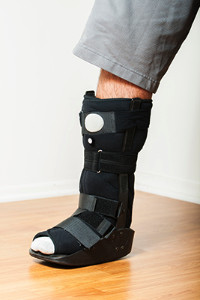 If you have fallen and have severe pain in your ankle, it may be broken. A noticeable symptom of this condition is extreme discomfort and an obvious deformity in the ankle and surrounding area. Walking will be unbearable as a result of the intense pain and swelling, and bruising may occur as the injury causes the blood to leak from the vessels. Many patients who have endured a broken ankle may be familiar with the painful feeling of crepitus, which is the name given to pieces of bone grinding together as a result of the broken ankle. After a proper diagnosis is performed, which will typically include having an X-ray taken. Once confirmation of a broken ankle is achieved, treatment can begin. This may include putting the ankle into a splint, cast, or walking boot. If you or someone you know has a broken ankle, it is suggested to speak with a podiatrist who can properly guide you to the best form of treatment.
If you have fallen and have severe pain in your ankle, it may be broken. A noticeable symptom of this condition is extreme discomfort and an obvious deformity in the ankle and surrounding area. Walking will be unbearable as a result of the intense pain and swelling, and bruising may occur as the injury causes the blood to leak from the vessels. Many patients who have endured a broken ankle may be familiar with the painful feeling of crepitus, which is the name given to pieces of bone grinding together as a result of the broken ankle. After a proper diagnosis is performed, which will typically include having an X-ray taken. Once confirmation of a broken ankle is achieved, treatment can begin. This may include putting the ankle into a splint, cast, or walking boot. If you or someone you know has a broken ankle, it is suggested to speak with a podiatrist who can properly guide you to the best form of treatment.
Broken ankles need immediate treatment. If you are seeking treatment, contact Dr. Dean D. Hinners from Illinois. Our doctor can provide the care you need to keep you pain-free and on your feet.
Broken Ankles
A broken ankle is experienced when a person fractures their tibia or fibula in the lower leg and ankle area. Both of these bones are attached at the bottom of the leg and combine to form what we know to be our ankle.
When a physician is referring to a break of the ankle, he or she is usually referring to a break in the area where the tibia and fibula are joined to create our ankle joint. Ankles are more prone to fractures because the ankle is an area that suffers a lot of pressure and stress. There are some obvious signs when a person experiences a fractured ankle, and the following symptoms may be present.
Symptoms of a Fractured Ankle
- Excessive pain when the area is touched or when any pressure is placed on the ankle
- Swelling around the area
- Bruising of the area
- Area appears to be deformed
If you suspect an ankle fracture, it is recommended to seek treatment as soon as possible. The sooner you have your podiatrist diagnose the fracture, the quicker you’ll be on the way towards recovery.
If you have any questions, please feel free to contact one of our offices located in Metropolis and Eldorado, IL . We offer the newest diagnostic and treatment technologies for all your foot care needs.
Read more about All About Broken AnklesAll About Broken Ankles
Broken ankles are a serious injury that can lead to an inability to walk, function, and also cause a significant amount of pain. A broken ankle is a break in one of the three bones in your body that connect at the ankle joint, the tibia, the fibula, and the talus. The tibia and fibula are your two primary leg bones that connect at the knee, which sit directly upon the talus bone. This is protected by a fibrous membrane that allows for movement in our ankle joint. A broken ankle is usually caused by the foot rolling under or twisting too far, causing one of these three bones to snap.
A broken ankle is different from an ankle sprain, which occurs when the ligaments are ripped or torn but no bones have been broken. A sprain can still be very severe, causing bruising in the foot and an inability to hold your own weight, much like a broken ankle would. If you’re unable to stand, and suspect that you have a broken ankle, the first thing to do would be to get an immediate x-ray to determine the severity of the break.
A common cause of broken ankles is when the ankle is rolled over with enough pressure to break the bones. This usually happens during exercise, sports, or other physical activity. Another common cause is a fall or jump from a tall height.
One immediate treatment for pain relief is elevating the feet above your head to reduce blood flow to the injured area. You can also apply ice packs to your ankles to help reduce swelling, redness, inflammation, and pain. After these initial steps, getting a cast and staying off your feet as much as possible will aid in the recovery of the broken ankle. The less movement and stress the ankle has to endure, the more complete it will heal. A doctor can determine if surgery is needed in order to heal correctly. In these cases, an operation may be the only option to ensure the ability to walk properly again, followed by physical therapy and rehabilitation.
It is highly important to determine if surgery is needed early on, because a broken ankle can become much more severe than you realize. If not professionally treated, the broken ankle will inhibit your walking, daily functioning, and produce a large amount of pain. Treating your broken ankle early on will help prevent further damage to it.
Several Ways to Treat a Broken Ankle
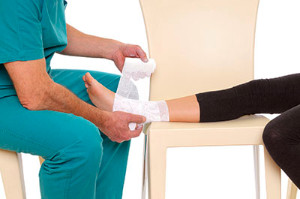 If you have fallen unexpectedly or stepped abruptly off a curb, you may have had the displeasure of experiencing an ankle sprain. It is typically the result of the ankle suddenly twisting or rolling, which may move the ankle out of alignment. There are several ligaments that surround the ankle and may tear if an ankle sprain occurs. There are several symptoms that may be associated with this condition, including noticeable swelling, bruising, and difficulty in bearing weight on the ankle. It’s important to have a proper diagnosis performed, which most likely may include having an X-ray taken. An MRI may be prescribed if the ankle sprain appears to be of a serious nature, or if damage has occurred to the surface of the ankle joint. There are many ways to treat a broken ankle, and this may depend on the severity of the injury. If you feel you have sprained your ankle, it is advised to consult with a podiatrist as quickly as possible who can determine the best course of treatment for you.
If you have fallen unexpectedly or stepped abruptly off a curb, you may have had the displeasure of experiencing an ankle sprain. It is typically the result of the ankle suddenly twisting or rolling, which may move the ankle out of alignment. There are several ligaments that surround the ankle and may tear if an ankle sprain occurs. There are several symptoms that may be associated with this condition, including noticeable swelling, bruising, and difficulty in bearing weight on the ankle. It’s important to have a proper diagnosis performed, which most likely may include having an X-ray taken. An MRI may be prescribed if the ankle sprain appears to be of a serious nature, or if damage has occurred to the surface of the ankle joint. There are many ways to treat a broken ankle, and this may depend on the severity of the injury. If you feel you have sprained your ankle, it is advised to consult with a podiatrist as quickly as possible who can determine the best course of treatment for you.
Although ankle sprains are common, they aren’t always minor injuries. If you need your ankle injury looked at, contact Dr. Dean D. Hinners from Illinois. Our doctor can provide the care you need to keep you pain-free and on your feet.
How Does an Ankle Sprain Occur?
Ankle sprains are the result of a tear in the ligaments within the ankle. These injuries may happen when you make a rapid shifting movement while your foot is planted. A less common way to sprain your ankle is when your ankle rolls inward while your foot turns outward.
What Are the Symptoms?
- Pain at the sight of the tear
- Bruising/Swelling
- Ankle area is tender to touch
- In severe cases, may hear/feel something tear
- Skin discoloration
Preventing a Sprain
- Wearing appropriate shoes for the occasion
- Stretching before exercises and sports
- Knowing your limits
Treatment of a Sprain
In many cases, the RICE method (Rest, Ice, Compression, and Elevate) is used to treat ankle sprains. However, you should see a podiatrist to see which treatment option would work best with your injury. In severe cases, surgery may be required.
It is important to ask your doctor about rehab options after you receive treatment for your injury. Stretching, strength training, and balance exercises may help the ankle heal while also preventing further injury.
If you have any questions, please feel free to contact one of our offices located in Metropolis and Eldorado, IL . We offer the newest diagnostic and treatment technologies for all your foot care needs.
Read more about Ankle Sprains

